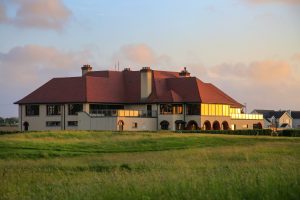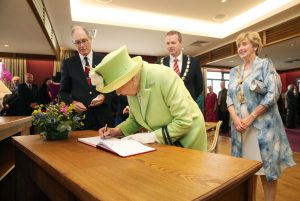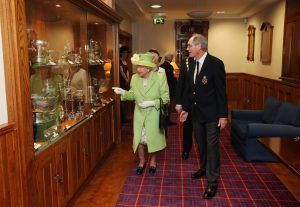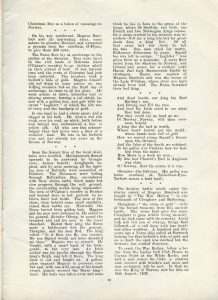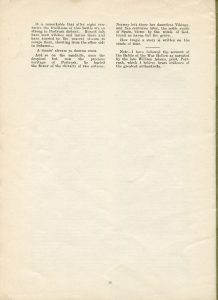18. Royal Portrush Golf Club

17. Robert Quigg VC Memorial
7th March 2023
19. Slaghtaverty
7th March 202318. Royal Portrush Golf Club
Royal Portrush Golf Club, originally called the County Golf Club, was formally opened in 1888. The club was granted permission by The Duke of York (later King George V) in 1892 to use the prefix ‘Royal’ in its name.
In 1895 the club changed its name to Royal Portrush Golf Club. Queen Elizabeth II visited Royal Portrush clubhouse during her 90th birthday tour in 2016.
According to local legend, ‘The War Hollow’ on the golf links at Royal Portrush, was the scene of a battle between the chieftains of the Route and Magnus Barefoot, King of Norway, in AD 1102.
Royal Portrush Golf Club
By Portrush Heritage Group
Royal Portrush Golf Club was formally opened on 12th May 1888. The club, which was then called the County Golf Club, was granted permission by The Duke of York (later King George V) on the 25th June 1892 to use the prefix ‘Royal’ in front of its name. In April 1895 the club changed its name to Royal Portrush Golf Club with the Prince of Wales (later King Edward) agreeing to be its new Patron.
On Tuesday 28th June 2016, as part of her 90th birthday tour of Northern Ireland, Her Majesty Queen Elizabeth II visited the Royal Portrush clubhouse – the first time the sovereign had visited any golf club during her reign.
- Royal Portrush Golf Club clubhouse. Courtesy of Gary Lisbon.
- Queen Elizabeth II signs the visitor book at Royal Portrush Golf Club.
- Queen Elizabeth II visiting Royal Portrush Golf Club, 28th June 2016.
The Legend of King Magnus Barefoot
Legend has it that the part of the golf links at Royal Portrush Golf Club known as the ‘The War Hollow’ was the scene of an ancient battle, in about 1102, between the chieftains of the Route and Magnus Barefoot, King of Norway. Local Legend records that Magnus was mortally wounded in the battle. He was the last Norwegian King to fall in battle abroad and is understood to have said “Kings are made for honour, not for long life”.
- The Battle of War Hollow from ‘Ulster Folk Tales’ by Sam Henry.
- The Battle of War Hollow from ‘Ulster Folk Tales’ by Sam Henry.
- The Battle of War Hollow from ‘Ulster Folk Tales’ by Sam Henry.
Sam Henry told the story of ‘The War Hollow’ in his 1939 book, Ulster Folktales, based on the narrative of William Adams, who wrote Dalriada, or North Antrim: A Historical Account of Some of Its Old Families and Ancient Castles. Adams also included the poem, ‘Death of Magnus Barefoot’, by Thomas D’Arcy McGee, in his 1906 book.
It was on St Bartholomew’s Eve off Ulla’s shore we lay
(Thus the importuned Scald began his tale of woe),
And faintly round our fleet fell the August evening grey,
And sadly the sunset winds did blow.
I stood beside our monarch – then deep care was on his brow-
“I hear no horn,” he signed, “from the shore;
Why tarry still, my errand men? ‘Tis time they were here now,
And that to some less guarded coast we go.”
Into the vernal west his errand men had gone –
To Muirkeartach, the ally of our king
(Whose daughter fair had wed Earl Sigurd, his son),
The dower of the bridegroom to bring.
‘Twas midnight in the firmament, ten thousand stars were there,
And from the darksome sea looked up other ten-
I lay beside our monarch; he was sleepless, and the care
On his brow had grown gloomier then.
When morning dawning gray in lightsome circles spread,
From his couch rose the king slowly up.
“Elldiarn! What! thou awake! I must landward go,” he said,
“And with you or the saints I will sup.”
Then when the sun arose; in his galley through the fleet
Our noble Magnus went; and the earls all awoke
And each prepared to land – the errand-men to meet
Or free them from the Irish yoke.
It was a noble army ascending the green hills
As ever kingly master led;
The memory of their marching my mournful bosom thrills,
And my ears catch the echoes of their tread.
Two hours passed away, and I wandered on the strand.
Battle cries from afar reached my ear;
I climbed the seaward hills and looked upon the land,
And, in sooth, I saw a sight of fear.
As winter rocks all jagged with the leafless arms of pines,
Stood the Irish host of spears in their path-
As the winter streams down dash through the terrible ravine,
So our men poured along, white with wrath.
The arrow-flights at intervals were thicker o’er the field
Than the sea birds o’er Jura’s rocks;
While the banners in the darkness were lost – shield on shield
Within it clashed in thund’rous shocks.
At last one hoarse “Farrah!” broke through the battle cloud
Like the roar of a billow in a cave,
And the darkness was uplifted like a plaque city’s shroud-
And there lifeless lay our monarch brave.
And dead beside our king lay Earl Erling’s son,
And Erving, and Ulf, the free.
And loud the Irish cried to see what they had done,
For they could cry as loud as we.
Oh Norway! Oh Norway! wilt thou ever more behold
A king like the last in worth,
Whose heart feared not the world, whose hands were full of gold
For the numberless Scalds of the North.
Ah, well do I remember how we swept the Western seas
Like the wind in its wintry mood-
How he reared young Sigurd’s throne upon the Orcades,
And the isles of the South subdued.
In his galley o’er Cantyre; how we bore him from the main-
How Mona in a week he won,
By him, how Chester’s earl in Anglesea was slain-
Oh Norway! that his course is run!
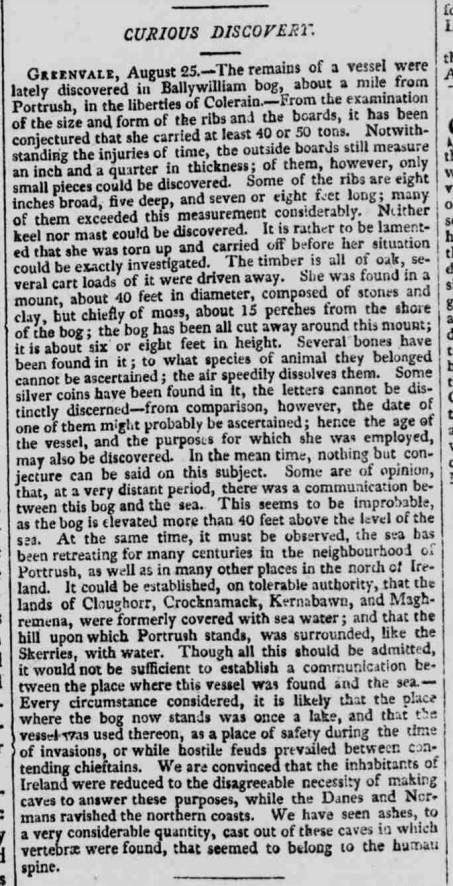
Newspaper clipping from the Caledonian Mercury, 13th September 1813.
Ballywillan Viking Ship
A report of a “Curious Discovery” appeared in the Caledonian Mercury of 13th September 1813 – “The remains of a vessel were lately discovered in Ballywilliam[1] bog, about a mile from Portrush, in the liberties of Colerain.”
The Ordnance Survey Memoirs confirmed the report. In August 1835, John Bleakley noted “About 15 years ago, the keel of a ship was found in Ballywillin Bog, when cutting the turf on Samuel Knox’s Farm.” A later note read, “A few pieces of ancient coin of silver was found in Ballywillin Bog with the old boat mentioned in a former page, and at the same time, by Andrew Knox farmer. The boat had no nails was put together with pegs of wood.”
Another published account differs slightly from the original, “in the bottom of the boat was found a quantity of white limestone gravel for ballast, and a large flat stone for a hearth at one end of her, and a quantity of ashes”.[2]
It is possible that the tradition of ‘The War Hollow’ being the scene of an ancient battle between the Irish and the Danes, derives from the discovery of the ship, but may have been strengthened by the fairly regular discovery of flint arrowheads in the vicinity. Magnus Barefoot is said to have been buried on Irish soil, however, the site of his grave has never been identified, though a mound close to Downpatrick known locally as ‘Magnus’ Grave’ has been put forward as a possibility. The discovery of such a large ship at Ballywillin (not certainly Viking, but buried in a manner characteristic of the Viking period) provided ample grounds upon which to speculate that Magnus, or another similarly distinguished warrior, may have been laid to rest there.[3]
[1] Ballywilliam is apparently the old name for the townland since this is the name which appears on the map of 1694 [S. Molyneux, The Giants Causeway, Phil. Trans. (1694), 212, 169-182]. Ballywillin may have come into use to avoid confusion with Ballywilliam (near Macosquin).
[2] Dalriada, or North Antrim: A Historical Account of Some of Its Old Families and Ancient Castles. (1906). W. Adams
[3] Briggs, C. Stephen. (1974). A boat burial from County Antrim. Medieval Archaeology 18. Vol 18, pp. 158-160.
Directions
Co-ordinates: 55.1996, -6.6357
This project is receiving financial support via the District Council Good Relations Programme.



